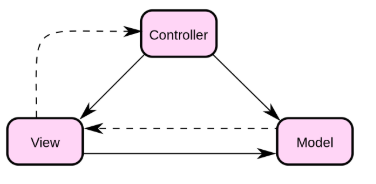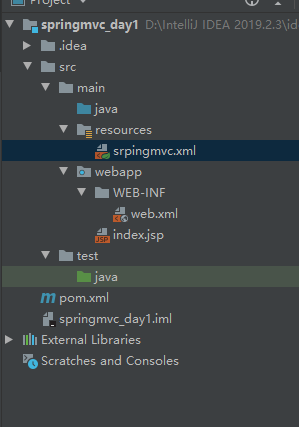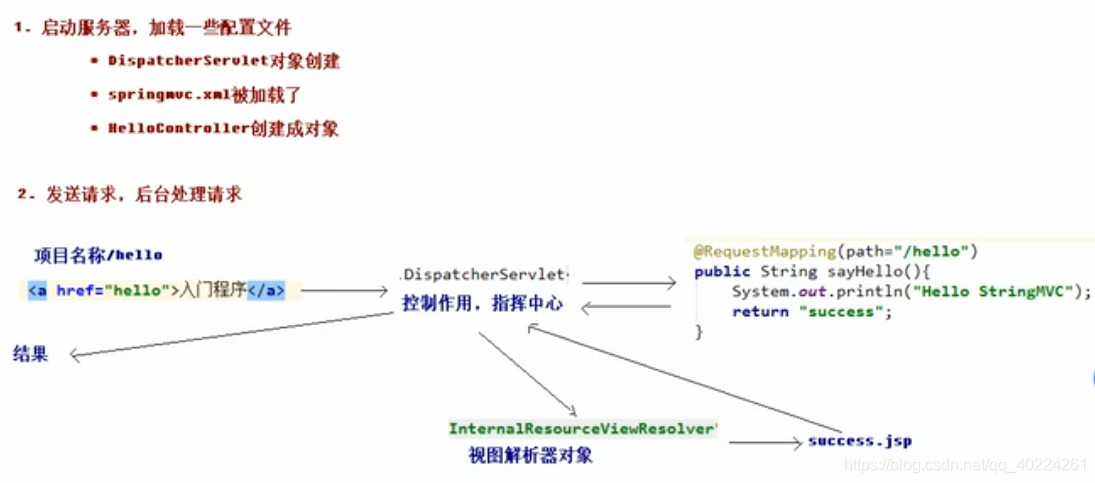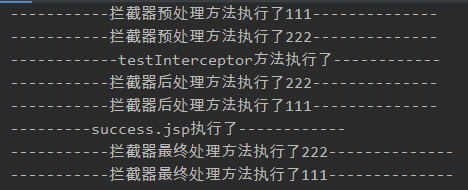目录
三层架构
我们的开发一般有两种形式:C/S架构,B/S架构,在JavaEE开发中,几乎都是基于B/S架构的开发。那么在B/S架构中,服务器端,系统标准的三层架构包括:表现层,业务层,持久层。

MVC模型
MVC 模式代表 Model-View-Controller(模型-视图-控制器) 模式。这种模式用于应用程序的分层开发。
-
Model(模型)
代表一个存取数据的java对象,也就是javaBean。 -
Vide(视图)
通常是我们的jsp或html,用于展示数据,一般依据数据模型创建的 -
Controller(控制器)
-
控制器作用于模型和视图上。它控制数据流向模型对象,并在数据变化时更新视图。它使视图与模型分离开。

SpringMVC概述
springmvc是什么
srpingmvc是一种基于java的实现mvc设计模型的请求驱动类型的轻量级web框架,属于spring framework的后续产品。支持resrful编程风格的请求。
springmvc和structs2比较
共同点:
1)都是表现层框架,都是基于mvc模型编写的
2)底层都是原始servletAPI
3)处理请求的机制都是一个核心控制器
区别:
1)spring mvc的入口是servllet,而structs2是filter
2)spring mvc(对象单例)是基于方法设计的,而structs(多例) 是基于类,structs是每次执行都会创建一个动作类,因此spring mvc 会比较快
3)spring mvc 使用更简洁,支持JSR303,处理ajax更方便
(JSR303 是一套javabean参数校验的标准,它定义了很多常用的校验注解,我们可以直接将这些注解加在我们javabean的属性上,就可以在需要校验的时候进行校验了)
4)structs的OGNL表达式使页面的开发效率优于spring mvc,但是执行效率并没有比JSTL提升,尤其是strucrs2的表单标签,远没有html执行效率高
springmvc 环境搭建
1)创建maven工程,选择

2):在创建Maven工程时加上 archetypeCatalog=internal参数

3)导入依赖
<dependency>
<groupId>org.springframework</groupId>
<artifactId>spring-context</artifactId>
<version>5.1.5.RELEASE</version>
</dependency>
<dependency>
<groupId>org.springframework</groupId>
<artifactId>spring-web</artifactId>
<version>5.1.5.RELEASE</version>
</dependency>
<dependency>
<groupId>javax.servlet</groupId>
<artifactId>javax.servlet-api</artifactId>
<version>3.1.0</version>
<scope>provided</scope>
</dependency>
<dependency>
<groupId>javax.servlet</groupId>
<artifactId>jsp-api</artifactId>
<version>2.0</version>
<scope>provided</scope>
</dependency>
<dependency>
<groupId>org.springframework</groupId>
<artifactId>spring-webmvc</artifactId>
<version>5.1.5.RELEASE</version>
</dependency>
<dependency>
<groupId>junit</groupId>
<artifactId>junit</artifactId>
<version>4.11</version>
<scope>test</scope>
</dependency>
4)补全目录结构

5)在web.xml中配置拦截
<servlet>
<servlet-name>dispatcherServlet</servlet-name>
<servlet-class>org.springframework.web.servlet.DispatcherServlet</servlet-class>
</servlet>
<servlet-mapping>
<servlet-name>dispatcherServlet</servlet-name>
<url-pattern>/</url-pattern>
</servlet-mapping>
spring的配置文件头部
<?xml version="1.0" encoding="UTF-8"?>
<beans xmlns="http://www.springframework.org/schema/beans"
xmlns:mvc="http://www.springframework.org/schema/mvc"
xmlns:aop="http://www.springframework.org/schema/aop"
xmlns:context="http://www.springframework.org/schema/context"
xmlns:xsi="http://www.w3.org/2001/XMLSchema-instance"
xsi:schemaLocation="
http://www.springframework.org/schema/beans
https://www.springframework.org/schema/beans/spring-beans.xsd
http://www.springframework.org/schema/aop
https://www.springframework.org/schema/aop/spring-aop.xsd
http://www.springframework.org/schema/context
https://www.springframework.org/schema/context/spring-context.xsd
http://www.springframework.org/schema/mvc
https://www.springframework.org/schema/mvc/spring-mvc.xsd">
<mvc:annotation-driven/>
</beans>
入门程序编写
实现点击页面链接,跳转页面
- web.xml
<!DOCTYPE web-app PUBLIC
"-//Sun Microsystems, Inc.//DTD Web Application 2.3//EN"
"http://java.sun.com/dtd/web-app_2_3.dtd" >
<web-app>
<display-name>Archetype Created Web Application</display-name>
<servlet>
<!--配置前端可控制器-->
<servlet-name>dispatcherServlet</servlet-name>
<servlet-class>org.springframework.web.servlet.DispatcherServlet</servlet-class>
<!--添加属性,加载springmvc.xml-->
<init-param>
<param-name>contextConfigLocation</param-name>
<param-value>classpath:springmvc.xml</param-value>
</init-param>
<!--使springmvc.xml在程序一运行就加载-->
<load-on-startup>1</load-on-startup>
</servlet>
<servlet-mapping>
<servlet-name>dispatcherServlet</servlet-name>
<url-pattern>/</url-pattern>
</servlet-mapping>
</web-app>
- springmvc.xml
<?xml version="1.0" encoding="UTF-8"?>
<beans xmlns="http://www.springframework.org/schema/beans"
xmlns:mvc="http://www.springframework.org/schema/mvc"
xmlns:aop="http://www.springframework.org/schema/aop"
xmlns:context="http://www.springframework.org/schema/context"
xmlns:xsi="http://www.w3.org/2001/XMLSchema-instance"
xsi:schemaLocation="
http://www.springframework.org/schema/beans
https://www.springframework.org/schema/beans/spring-beans.xsd
http://www.springframework.org/schema/aop
https://www.springframework.org/schema/aop/spring-aop.xsd
http://www.springframework.org/schema/context
https://www.springframework.org/schema/context/spring-context.xsd
http://www.springframework.org/schema/mvc
https://www.springframework.org/schema/mvc/spring-mvc.xsd">
<!--开启spring的注解扫描-->
<context:component-scan base-package="com.hwh"></context:component-scan>
<!--开启springmvc的注解扫描-->
<mvc:annotation-driven/>
<!--配置视图解析器-->
<bean id="internalResourceViewResolver" class="org.springframework.web.servlet.view.InternalResourceViewResolver">
<property name="prefix" value="/WEB-INF/pages/"></property>
<property name="suffix" value=".jsp"></property>
</bean>
</beans>
- HelloController.java
package com.hwh.controller;
import org.springframework.stereotype.Controller;
import org.springframework.web.bind.annotation.RequestMapping;
import javax.xml.ws.RequestWrapper;
/**
* @Description TODO
* @Author hwh
* @Date 2020/1/5 16:14
**/
@Controller
public class HelloController {
@RequestMapping(path = "/hello")
public String first(){
System.out.println("success");
return "success";
}
}
- index.jsp
<%--
Created by IntelliJ IDEA.
User: AIR
Date: 2020/1/5
Time: 16:12
To change this template use File | Settings | File Templates.
--%>
<%@ page contentType="text/html;charset=UTF-8" language="java" %>
<html>
<head>
<title>Title</title>
</head>
<body>
<h1>入门程序11</h1>
<a href="hello">点击入门程序</a>
</body>
</html>
- success.jsp
<%--
Created by IntelliJ IDEA.
User: AIR
Date: 2020/1/5
Time: 16:13
To change this template use File | Settings | File Templates.
--%>
<%@ page contentType="text/html;charset=UTF-8" language="java" %>
<html>
<head>
<title>Title</title>
</head>
<body>
<h1>成功</h1>
</body>
</html>
springmvc工作流程(原理)
springmvc是基于组件方式执行流程,所谓组件就是各个器,如处理器映射器等
- 根据代码进行简单分析

- 详细介绍

1)客户端发送请求到前端控制器
2)前端控制器让处理器映射器(HandlerMapping)去查找handler(也就是controller类中的方法),并返回一个执行链
3)通过处理器适配器,找到响应的Handler(处理器),执行handler方法,并返回一个modelandview
4)通过视图解析器去解析modelandview并返回一个view
5)渲染到视图,展示给客户
- 各个组件
1)DispatherServlet(前端控制器):
整个流程的控制中心,它的存在可以降低各个组件间的耦合性
2)HandlerMapping(处理器映射器)
根据用户请求,找到响应的处理器(hander)
3)Handler(处理器)
开发中要编写的具体业务控制器
4)HandlAdapter(处理器适配器)
找到响应的适配器
5)View Resolver (视图解析器)
将处理结果生成view
6)View(视图)
渲染页面
注意:
<mvc:annotation-driven/> 自动加载处理器映射器和处理器适配器
解决post请求中文乱码问题(使用过滤器filter)
<!--解决中文乱码问题-->
<filter>
<filter-name>characterEncodingFilter</filter-name>
<filter-class>org.springframework.web.filter.CharacterEncodingFilter</filter-class>
<init-param>
<param-name>encoding</param-name>
<param-value>utf-8</param-value>
</init-param>
</filter>
<filter-mapping>
<filter-name>characterEncodingFilter</filter-name>
<url-pattern>/*</url-pattern>
</filter-mapping>
请求参数绑定
- 传递对象以及对象中包含对象的情况
jsp发送请求:
<form action="test" method="post">
姓名:
<input type="text" name="userName"><br>
密码:
<input type="text" name="password"><br>
用户姓名:
<input type="text" name="user.uname"><br>
性别:
<input type="text" name="user.sex"><br>
<input type="submit" value="提交">
</form>
controller层接受请求:
@RequestMapping(path = "/test")
private String testParam(Account account){
System.out.println(account);
System.out.println(account.getUser());
return "success";
}
- 参数绑定集合类型
account类
private Integer id;
private String userName;
private String password;
private List<User> userList;
private Map<String,User> userMap;
jsp
<form action="test" method="post">
姓名:
<input type="text" name="userName"><br>
密码:
<input type="text" name="password"><br>
用户姓名:
<input type="text" name="userList[0].uname"><br>
性别:
<input type="text" name="userList[0].sex"><br>
用户姓名:
<input type="text" name="userMap['one'].uname"><br>
性别:
<input type="text" name="userMap['one'].sex"><br>
<input type="submit" value="提交">
</form>
controller类
@RequestMapping(path = "/test")
private String testParam(Account account){
System.out.println(account);
return "success";
}
自定义类型转换器
步骤:
1、编写转换类,继承于converter接口、
package com.hwh.utils;
import javafx.scene.input.DataFormat;
import org.springframework.core.convert.converter.Converter;
import java.text.DateFormat;
import java.text.ParseException;
import java.text.SimpleDateFormat;
import java.util.Date;
/**
* @Description TODO
* @Author hwh
* @Date 2020/1/7 11:14
**/
public class StringConverter implements Converter<String, Date> {
@Override
public Date convert(String s) {
if(s==null){
throw new RuntimeException("没有参数传入");
}
try {
DateFormat df = new SimpleDateFormat("yy-MM-dd");
return df.parse(s);
} catch (ParseException e) {
throw new RuntimeException("数据类型转换出现错误");
}
}
}
2、在xml中创建ConversionServiceFactoryBean的bean对象,并将自定义转换器注入
<!--注册自定义类型转换器-->
<bean id="conversionServiceFactoryBean" class="org.springframework.context.support.ConversionServiceFactoryBean">
<property name="converters">
<set>
<bean class="com.hwh.utils.StringConverter"></bean>
</set>
</property>
</bean>
3、让方法生效
<mvc:annotation-driven conversion-service="conversionServiceFactoryBean"/>
获取原生servlet的API
/**
* 获取原生servlet的API
* @param request
* @param response
* @return
*/
@RequestMapping(path = "/selvet")
private String getServletAPI(HttpServletRequest request, HttpServletResponse response){
System.out.println(request);
HttpSession session = request.getSession();
System.out.println(session);
System.out.println(response);
return "success";
}
常见注解
@RequestMapping
- 作用
建立请求url和处理请求方法之间的对应关系 - 位置
可以添加在类上或者方法上,添加在类上相当于建立一级目录,而添加在方法上相当于建立二级目录,有利于分模块开发 - 属性
1)path:配置映射路径
2)value:与path作用同
3)method:当前的方法可以接受什么样的请求方式,get或post
method = {RequestMethod.GET}
4)params:指定限制请求参数的条件
params = {"username"} 表示所发送的请求必须传username属性,否则方法不执行
5)headers:发送的请求必须包含请求头
@RequestParam
当插入参数名称与接收时名称不一致的情况下使用
示例:
<a href="requestParam?username=hh">点击入门程序</a>
@RequestMapping(path = "/requestParam")
private String requestParam(@RequestParam("username") String name){
System.out.println(name);
return "success";
}
@RequestBody
作用:用于获得请求体内容,直接使用得到的是key=value&key=value…结构的数据。
get方法不适用
用法:
@RequestMapping(path = "/RequestBody")
private String testRequestBody(@RequestBody User user){
System.out.println(user);
return "success";
}
@PathVariable
作用:用于绑定url中的占位符,获取占位符中内容,在使用restful的编程风格的时候通常会用到。
代码示例:
<a href="PathVariable/10">点击入门程序</a>
@RequestMapping(path = "/PathVariable/{uid}")
private String testPathVariable(@PathVariable(value = "uid") Integer id){
System.out.println(id);
return "success";
}
@RequestHeader(用的较少)
作用:用于获取请求消息头,可以用于反爬虫
属性:
value:提供消息头名称(如Accpet)
required:是否必须有此消息头
代码示例:
@RequestMapping(path = "/PathVariable")
private String testPathVariable(@RequestHeader(value = "Accept") String header){
System.out.println(header);
return "success";
}
@CookieValue
作用:获取指定cookie名称的值
属性:
value 指定cookie的名称
required 是否不许有此cookie
示例代码:
@RequestMapping(path = "/CookieValue")
private String testCookieValue(@CookieValue(value = "JSESSIONID") String cookie){
System.out.println(cookie);
return "success";
}
@ModelAttribute
作用:
该注解是springmvc4.3版本以后新加入的,他可以用于修饰方法和参数
出现在方法上,表示当前方法会在控制器方法执行之前先执行。它可以修饰没有返回值的方法,也可以修饰具有返回值的方法。
出现在参数上,获取指定的数据给参数赋值
属性:
value:用于获取数据的key,key可以是POJO的属性名称,也可以是map结构的key
应用场景:
当表单提交不是完整的实体类数据时,保证没有提交数据的字段使用数据库对象原来的数据
代码示例:
jsp代码:
<%--
Created by IntelliJ IDEA.
User: AIR
Date: 2020/1/5
Time: 16:12
To change this template use File | Settings | File Templates.
--%>
<%@ page contentType="text/html;charset=UTF-8" language="java" %>
<html>
<head>
<title>Title</title>
</head>
<body>
<h1>入门程序11</h1>
<form action="user" method="post">
用户名:
<input type="text" name="uname"><br>
性别:
<input type="text" name="sex"><br>
<input type="submit" value="提交">
</form>
</body>
</html>
- 当用在方法上时(也就是方法有返回值的情况)
controller类方法
@RequestMapping(path = "/user")
public String getUser(User user){
System.out.println("------getUser执行了-------");
System.out.println(user);
return "success";
}
@ModelAttribute
public User beforeUser(String username){
System.out.println("------beforeUser执行了-------");
//模拟通过username从数据库中读取user
User user = new User();
user.setUname(username);
user.setSex("女");
user.setBirthday(new Date());
return user;
}
- 当用在参数上时(也就是方法没有返回值的情况)
controller类方法
@RequestMapping(path = "/user")
public String getUser(@ModelAttribute(value = "one") User user){
System.out.println("------getUser1执行了-------");
System.out.println(user);
return "success";
}
@ModelAttribute
public void beforeUser(String username, Map<String,User> map){
System.out.println("------beforeUser1执行了-------");
//模拟通过username从数据库中读取user
User user = new User();
user.setUname(username);
user.setSex("女");
user.setBirthday(new Date());
map.put("one",user);
// return user;
}
运行结果:

@SessionAttributes
作用:
用于多次执行控制器方法见的参数共享
属性:
value:用于指定存入的属性名称
type:用于指定存入的数据类型
代码示例:
jsp中的代码:
<%--
Created by IntelliJ IDEA.
User: AIR
Date: 2020/1/5
Time: 16:12
To change this template use File | Settings | File Templates.
--%>
<%@ page contentType="text/html;charset=UTF-8" language="java" %>
<html>
<head>
<title>Title</title>
</head>
<body>
<h1>入门程序</h1>
<%-- <a href="requestParam?username=hh">点击入门程序</a>--%>
<a href="putSession">putSession</a>
<a href="getSession">getSession</a>
<a href="clearSession">clearSession</a>
</form>
</body>
</html>
controller类代码:
/**
* 将map值传入session阈中
* @param model
* @return
*/
@RequestMapping(path = "/putSession")
public String putSession(Model model){
System.out.println("------putSession执行了-------");
Map<String,String> map = new HashMap<>();
//存入到request域对象中
model.addAttribute("msg","name");
return "success";
}
/**
* 获取session的值
* @param modelMap
* @return
*/
@RequestMapping(path = "/getSession")
public String getSession(ModelMap modelMap){
System.out.println("------getSession执行了-------");
String msg = (String) modelMap.get("msg");
System.out.println(msg);
return "success";
}
/**
* 清除session值
* @param status
* @return
*/
@RequestMapping(path = "/clearSession")
public String clearSession(SessionStatus status){
System.out.println("------clearSession执行了-------");
status.setComplete();
return "success";
}
restful编程风格
-
什么是restful
是一种设计风格 -
优点
结构清晰,易于理解、扩展方便 -
特性
资源:网络上的一个具体信息,每个资源有一个URI(统一资源定位符)。获取这个资源,访问他的URI就可以,因此URI为每一个资源的独一无二的识别符
表现层:把资源呈现出来的形式,叫做它的表现层
比如,文本可以用txt或者json,xml等格式展现
状态转化:
http协议里面,四种请求方式:get,post,put和delete。
get用来获取资源,post用来新建资源,post用来更新资源,delete用来删除资源 -
图解

普通的方式可以通过请求路径的不同,从而让不同的方法去接受这个请求,而restful风格的设计是路径相同,通过请求方法不同的形式,让不同的方法处理请求,以及将需要传递的参数也放在路径已达到目的。
响应请求的四种方式
响应之后返回值是string类型
/**
* 响应之后返回string类型
* @param model
* @return
*/
@RequestMapping("/testGetUser")
public String getUser(Model model){
System.out.println("---------getUser方法执行了-----------");
//模拟从数据库中取出user对象
User user = new User();
user.setUserName("zhangsan");
user.setPassword("123");
user.setAge(12);
model.addAttribute("user",user);
return "success";
}
响应之后返回值是void类型
/**
* 响应之后返回值是void类型
* @param request
* @param response
* @throws ServletException
* @throws IOException
*/
@RequestMapping("/testVoid")
public void testVoid(HttpServletRequest request, HttpServletResponse response) throws ServletException, IOException {
System.out.println("---------testVoid方法执行了-----------");
//转发,一次请求
// request.getRequestDispatcher("/WEB-INF/pages/success.jsp").forward(request,response);
//重定向,两次请求,不能访问WEB-INF下的jsp文件
// response.sendRedirect(request.getContextPath()+"/response.jsp");
//解决中文乱码问题
response.setCharacterEncoding("utf-8");
response.setContentType("text/html;charset=utf-8");
//直接进行响应
response.getWriter().print("你好");
}
响应之后返回值是ModelAndVies类型
/**
* 响应之后返回值是ModelAndView类型
* @return
*/
@RequestMapping("/testModelAndView")
public ModelAndView testModelAndView(){
System.out.println("---------testModelAndView方法执行了-----------");
//模拟从数据库中取出user对象
ModelAndView modelAndView = new ModelAndView();
User user = new User();
user.setUserName("zhangsan");
user.setPassword("123");
user.setAge(12);
modelAndView.addObject("user",user);
modelAndView.setViewName("success");
return modelAndView;
}
使用forward和redirect关键字进行页面跳转
注意:使用关键字的方式不会经过视图解析器,因此在路径的填写上需要填写完整路径。
代码示例:
@RequestMapping("/testForward")
public String testForward() {
System.out.println("---------testForward方法执行了-----------");
//转发
// return "forward:/WEB-INF/pages/success.jsp";
//重定向
return "redirect:/response.jsp";
}
发送ajax请求并响应(数据传输以json格式进行传输)
首先需要导入jackson相关的jar包
<!-- jackson-->
<dependency>
<groupId>com.fasterxml.jackson.core</groupId>
<artifactId>jackson-core</artifactId>
<version>2.9.8</version>
</dependency>
<dependency>
<groupId>com.fasterxml.jackson.core</groupId>
<artifactId>jackson-annotations</artifactId>
<version>2.9.8</version>
</dependency>
<dependency>
<groupId>com.fasterxml.jackson.core</groupId>
<artifactId>jackson-databind</artifactId>
<version>2.9.8</version>
</dependency>
发送ajax请求代码:
<%@ page contentType="text/html;charset=UTF-8" language="java" %>
<html>
<head>
<title>index</title>
<%-- <script src="http://ajax.aspnetcdn.com/ajax/jQuery/jquery-1.8.0.js"></script>--%>
<script src="js/jquery-min.js"></script>
<script>
//页面加载绑定单击事件
$(function () {
$("#btn").click(function () {
// alert("发送请求222")
//发送ajax请求
$.ajax({
url:"user/testAjax",
contentType:"application/json;charset=utf-8",
data:'{"userName":"Tom","password":"123","age":1}',
dataType:"json",
type:"post",
success:function (data) {
alert(data)
alert(data.userName)
}
})
})
})
</script>
</head>
<body>
<button id="btn">发送ajax请求</button>
</body>
</html>
响应请求代码:
/**
* 响应ajax请求
* 通过@RequestBody获取请求体,并塞入user中
* @ResponseBody将返回的uer转化为json格式
* @param user
* @return
*/
@RequestMapping(value = "/testAjax",method = RequestMethod.POST)
@ResponseBody
public User testAjax(@RequestBody User user) {
System.out.println("---------testAjax方法执行了-----------");
System.out.println(user.toString());
user.setUserName("Jerry");
return user;
}
文件上传
传统方式
文件上传的必要前提
1)form表单的enctype取值为multipart/form-data(将请求内容分部分)
2)method的属性为post
3)提供一个文件选择域
文件上传原理


传统文件上传方式需借助第三方组组件实现文件上传

主要代码:
- 导入的jar包
<!-- 第三方jar包实现文件上传 -->
<dependency>
<groupId>commons-io</groupId>
<artifactId>commons-io</artifactId>
<version>2.4</version>
</dependency>
<dependency>
<groupId>commons-fileupload</groupId>
<artifactId>commons-fileupload</artifactId>
<version>1.3.1</version>
</dependency>
- jsp文件代码:
<body>
<form action="testFile" method="post" enctype="multipart/form-data">
选择文件:<input type="file" name="upload"><br><br>
<input type="submit" value="上传">
</form>
</body>
- 控制层代码:
@RequestMapping("/testFile")
public String testFile(HttpServletRequest request) throws Exception {
System.out.println("--------testFile方法执行了-------");
//上传路径
String path = request.getSession().getServletContext().getRealPath("/upload");
System.out.println(path);
File file = new File(path);
//判断文件夹是否存在,若不存在,则创建一个
if(!file.exists()){
file.mkdir();
}
//解析上传文件,获取上传资源
DiskFileItemFactory factory = new DiskFileItemFactory();
ServletFileUpload upload = new ServletFileUpload(factory);
//解析request
List<FileItem> fileItems = upload.parseRequest(request);
for (FileItem item:fileItems){
//判断当前item是否为文件上传项
if(item.isFormField()){
}else {
//获取上传文件的名称
String filename = item.getName();
String uuid = UUID.randomUUID().toString().replace("-","");
filename = uuid+"-"+filename;
//完成文件上传
item.write(new File(path,filename));
//删除临时文件
item.delete();
}
}
return "success";
}
springmvc文件上传
实现原理:
springmvc框架为我们提供了一个文件解析器,帮助我们解析request,然后通过MultipartFile的transfor方法实现文件上传。

注意点:
1)文件解析器(CommonsMultipartResolver)的bean 的id必须为multipartResolver
2)MultipartFile 类名字需要与form表单中<input type="file" name="upload">的name名称相一致
代码示例:
- 文件解析器配置:
<!--配置文件解析器,id必须为multipartResolver-->
<bean id="multipartResolver" class="org.springframework.web.multipart.commons.CommonsMultipartResolver">
<property name="maxUploadSize" value="10485760"></property>
</bean>
- 控制层代码:
/**
* @param request
* @param upload 需要与表单中文件名字相同
* @return
* @throws Exception
*/
@RequestMapping("/testSpringMvcFile")
public String testSpringMvcFile(HttpServletRequest request, MultipartFile upload) throws Exception {
System.out.println("--------testSpringMvcFile1方法执行了-------");
//上传路径
String path = request.getSession().getServletContext().getRealPath("/upload");
System.out.println(path);
File file = new File(path);
//判断文件夹是否存在,若不存在,则创建一个
if (!file.exists()) {
file.mkdir();
}
//解析request
//获取上传文件的名称
String filename = upload.getOriginalFilename();
String uuid = UUID.randomUUID().toString().replace("-", "");
filename = uuid + "-" + filename;
//完成文件上传
upload.transferTo(new File(path,filename));
return"success";
}
跨服务器实现文件上传


springmvc的异常处理
异常处理思路

controller调用service,service调用dao,异常都是向上抛出的,最终有前端处理器找到异常处理器进行异常处理
springmvc异常处理示例小代码
- 步骤
1)编写自定义异常类(做提示信息)
2)编写异常处理器
3)配置异常处理器(跳转到提示页面)
示例代码:
- index.jsp
<%--
Created by IntelliJ IDEA.
User: AIR
Date: 2020/1/9
Time: 15:13
To change this template use File | Settings | File Templates.
--%>
<%@ page contentType="text/html;charset=UTF-8" language="java" %>
<html>
<head>
<title>Title</title>
</head>
<body>
<h1>方法执行</h1>
<a href="error/testError">异常执行</a>
</body>
</html>
- error.jsp
<%--
Created by IntelliJ IDEA.
User: AIR
Date: 2020/1/9
Time: 15:13
To change this template use File | Settings | File Templates.
--%>
<%@ page contentType="text/html;charset=UTF-8" language="java" isELIgnored="false" %>
<html>
<head>
<title>Title</title>
</head>
<body>
<h1>异常页面</h1>
${error}
</body>
</html>
- 自定义异常类
package com.hwh.entity;
/**
* @Description 自定义异常类
* @Author hwh
* @Date 2020/1/9 15:32
**/
public class SysException extends Exception {
private String message;
public SysException(String message) {
this.message = message;
}
public String getMessage() {
return message;
}
public void setMessage(String message) {
this.message = message;
}
}
- 异常处理器类
package com.hwh.exceprion;
import com.hwh.entity.SysException;
import org.springframework.stereotype.Controller;
import org.springframework.web.servlet.HandlerExceptionResolver;
import org.springframework.web.servlet.ModelAndView;
import javax.servlet.http.HttpServletRequest;
import javax.servlet.http.HttpServletResponse;
/**
* @Description 异常处理器
* @Author hwh
* @Date 2020/1/9 15:34
**/
@Controller
public class ExceptionResolver implements HandlerExceptionResolver {
@Override
public ModelAndView resolveException(HttpServletRequest httpServletRequest, HttpServletResponse httpServletResponse, Object o, Exception e) {
SysException sysException = null;
if(e instanceof SysException){
sysException = (SysException)e;
}else {
sysException = new SysException("系统正在维护");
}
ModelAndView mv = new ModelAndView();
mv.addObject("error", sysException.getMessage());
mv.setViewName("error");
return mv;
}
}
- 控制层类
package com.hwh.controller;
import com.hwh.entity.SysException;
import org.omg.CORBA.SystemException;
import org.springframework.stereotype.Controller;
import org.springframework.web.bind.annotation.RequestMapping;
/**
* @Description TODO
* @Author hwh
* @Date 2020/1/9 15:14
**/
@Controller
@RequestMapping("/error")
public class ErrorController {
@RequestMapping("/testError")
public String testError() throws SysException {
System.out.println("--------testError方法执行了--------");
try {
int i= 10/0;
} catch (Exception e) {
e.printStackTrace();
throw new SysException("发生错误");
}
return "error";
}
}
springmvc拦截器
spring mvc中的拦截器类似于servlet中的过滤器filter,用于对处理器进行预处理和后处理。我们要自定义拦截器,必须实现HandlerInterceptor接口
拦截器和过滤器的区别:
1)过滤器是servlet规范中的一部分,任何java web工程都可以使用
过滤器是springmvc框架自己的,只有使用了springmvc框架的工程才能使用
2)过滤器在url-pattern中配置了/*之后,可以对所有要访问的资源拦截。
拦截器只会拦截访问的控制器方法,如果访问的是jsp,html,css,image或者js是不会进行拦截的
总结:拦截器能做的事,过滤器全部能做,过滤器能做的事,拦截器不一定能做。
拦截器链:
其实就是多个拦截器,一个拦截器执行完后去执行下一个

springmvc拦截器入门小程序
主要代码:
- index.jsp
<body>
<h1>拦截器</h1>
<a href="interceptor/testInterceptor">拦截器</a>
</body>
- success.jsp
<body>
<h1>方法执行成功</h1>
<% System.out.println("---------success.jsp执行了------------"); %>
</body>
- error.jsp
<body>
<h1>错误页面</h1>
</body>
- InterceptorController.java
package com.hwh.controller;
import org.springframework.stereotype.Controller;
import org.springframework.web.bind.annotation.RequestMapping;
/**
* @Description TODO
* @Author hwh
* @Date 2020/1/9 19:20
**/
@Controller
@RequestMapping("/interceptor")
public class InterceptorController {
@RequestMapping("/testInterceptor")
public String testInterceptor(){
System.out.println("------------testInterceptor方法执行了------------");
return "success";
}
}
- Interceptor.java(重写拦截器方法)
package com.hwh.utils;
import org.springframework.lang.Nullable;
import org.springframework.web.servlet.HandlerInterceptor;
import org.springframework.web.servlet.ModelAndView;
import javax.servlet.http.HttpServletRequest;
import javax.servlet.http.HttpServletResponse;
/**
* @Description 自定义拦截器类
* @Author hwh
* @Date 2020/1/9 19:24
**/
public class Interceptor implements HandlerInterceptor {
/**
* 预处理,在contoller方法前执行
* return true方形,执行下一个拦截器方法,若没有,执行controller中的方法
* return false 不放行
* @param request
* @param response
* @param handler
* @return
* @throws Exception
*/
public boolean preHandle(HttpServletRequest request, HttpServletResponse response, Object handler) throws Exception {
System.out.println("-----------拦截器预处理方法执行了--------------");
return true;
}
/**
* 在controller方法之执行
* @param request
* @param response
* @param handler
* @param modelAndView
* @throws Exception
*/
public void postHandle(HttpServletRequest request, HttpServletResponse response, Object handler, @Nullable ModelAndView modelAndView) throws Exception {
System.out.println("-----------拦截器后处理方法执行了--------------");
//跳到error页面之后就不会再跳到success的页面了,但是success仍会执行
// request.getRequestDispatcher("/WEB-INF/pages/error.jsp").forward(request,response);
}
/**
* 在最终执行
* @param request
* @param response
* @param handler
* @param ex
* @throws Exception
*/
public void afterCompletion(HttpServletRequest request, HttpServletResponse response, Object handler, @Nullable Exception ex) throws Exception {
System.out.println("-----------拦截器最终处理方法执行了--------------");
}
}
- springmvc.xml
<!--配置拦截器-->
<mvc:interceptors>
<mvc:interceptor>
<!--配置要拦截的方法-->
<mvc:mapping path="/interceptor/**"/>
<!--配置不拦截的方法-->
<!-- <mvc:exclude-mapping path=""/>-->
<bean class="com.hwh.utils.Interceptor"></bean>
</mvc:interceptor>
</mvc:interceptors>
- 运行结果:

配置多个拦截器
<!--配置拦截器-->
<mvc:interceptors>
<mvc:interceptor>
<!--配置要拦截的方法-->
<mvc:mapping path="/interceptor/**"/>
<!--配置不拦截的方法-->
<!-- <mvc:exclude-mapping path=""/>-->
<bean class="com.hwh.utils.Interceptor"></bean>
</mvc:interceptor>
<!--配置第二个拦截器-->
<mvc:interceptor>
<!--配置要拦截的方法-->
<mvc:mapping path="/interceptor/**"/>
<!--配置不拦截的方法-->
<!-- <mvc:exclude-mapping path=""/>-->
<bean class="com.hwh.utils.Interceptor2"></bean>
</mvc:interceptor>
</mvc:interceptors>
- 运行结果:






















 1万+
1万+











 被折叠的 条评论
为什么被折叠?
被折叠的 条评论
为什么被折叠?








